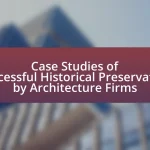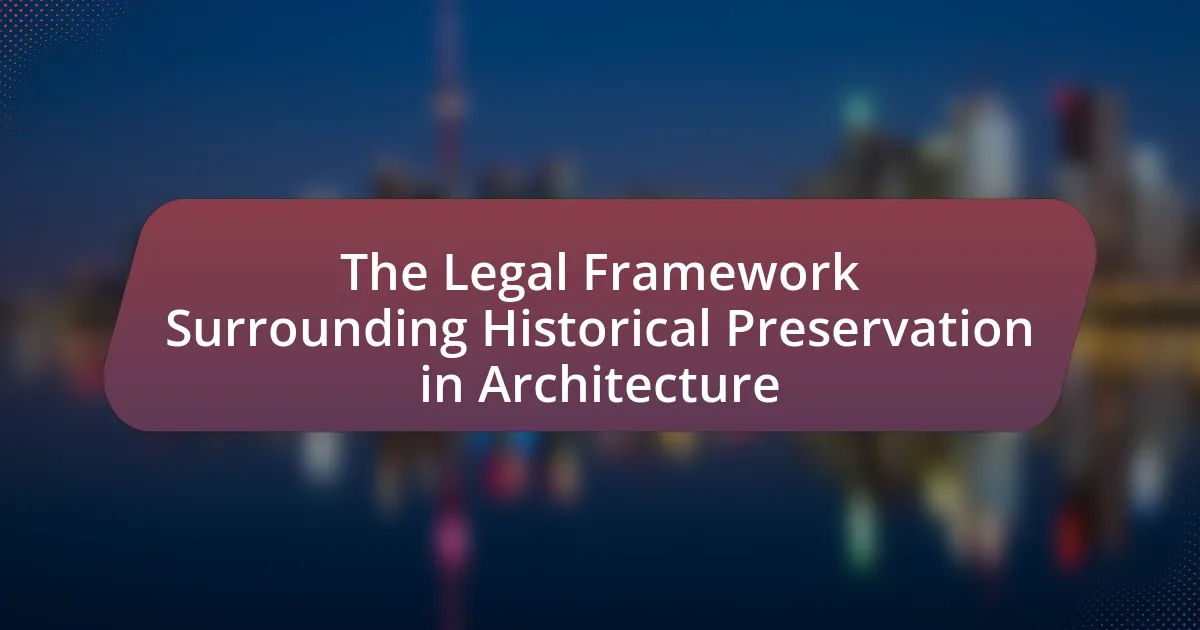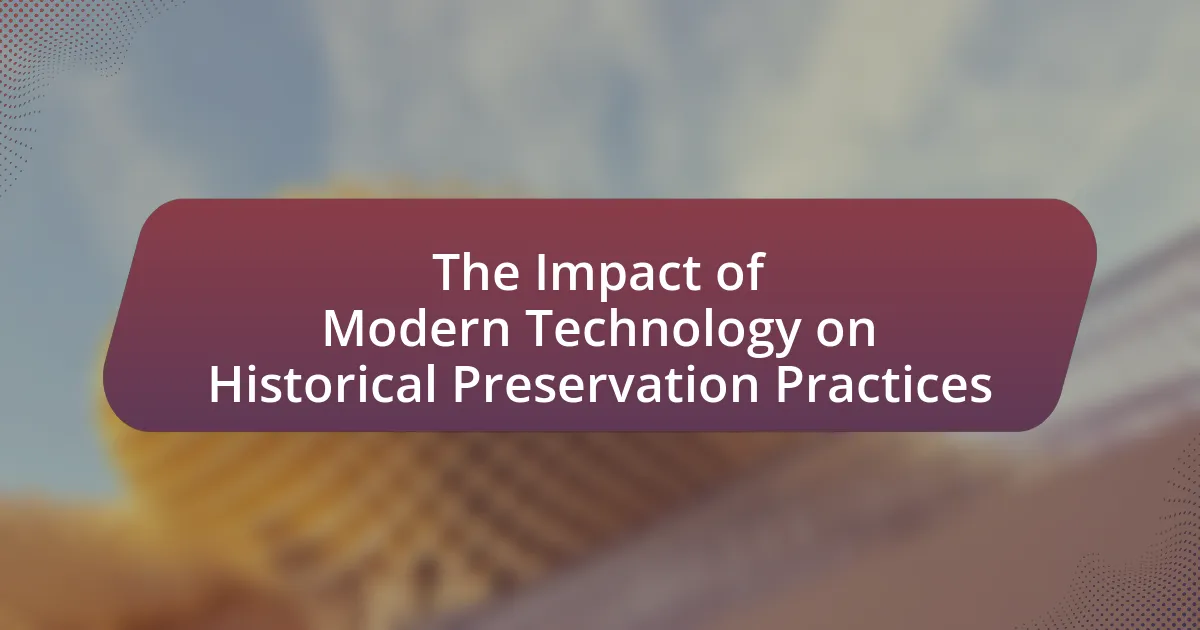Community involvement in historical preservation initiatives is the active participation of local residents and organizations in protecting and promoting historical sites and cultural heritage. This involvement is essential for fostering ownership and responsibility, leading to sustainable preservation efforts that enhance social cohesion and economic benefits. The article explores the roles community members play, the strategies for engagement, the challenges faced, and the impact of partnerships with local organizations. It also highlights successful case studies and the importance of diverse voices in shaping historical narratives, ultimately demonstrating how community engagement contributes to the effectiveness and sustainability of preservation initiatives.
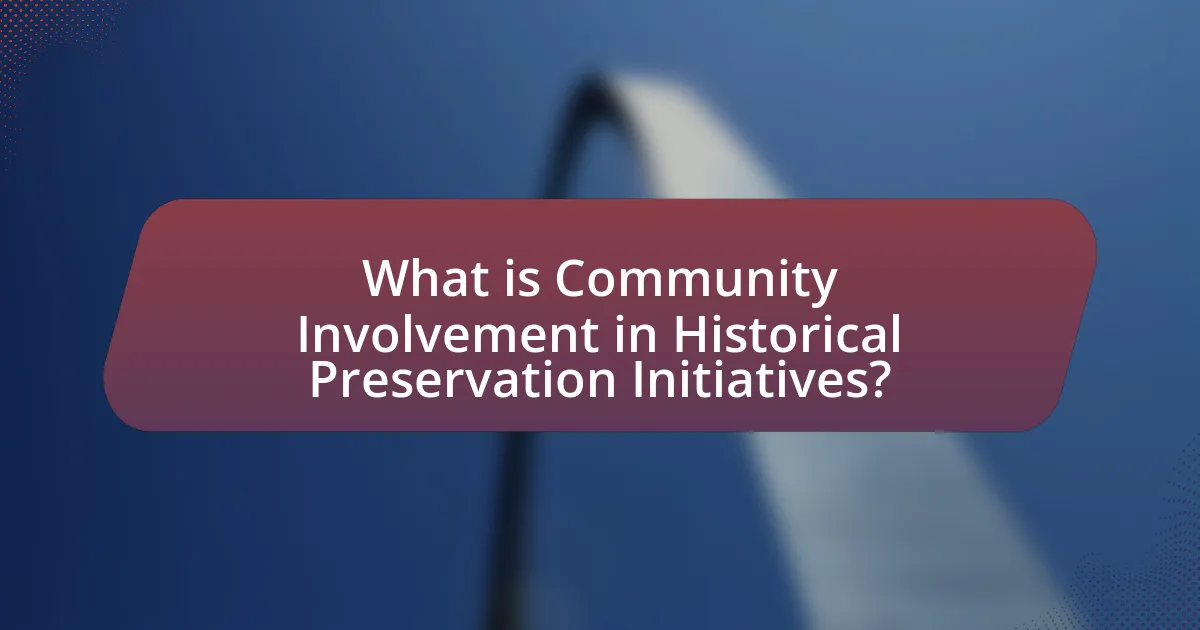
What is Community Involvement in Historical Preservation Initiatives?
Community involvement in historical preservation initiatives refers to the active participation of local residents and organizations in the efforts to protect, conserve, and promote historical sites and cultural heritage. This involvement is crucial as it fosters a sense of ownership and responsibility among community members, leading to more sustainable preservation efforts. Studies have shown that communities that engage in preservation initiatives often experience enhanced social cohesion and economic benefits, as seen in the revitalization of neighborhoods through heritage tourism. For example, the National Trust for Historic Preservation highlights that community-led projects can increase local engagement and funding opportunities, demonstrating the effectiveness of grassroots involvement in preserving historical assets.
Why is community involvement crucial for historical preservation?
Community involvement is crucial for historical preservation because it fosters a sense of ownership and responsibility among local residents, ensuring that historical sites are valued and maintained. When communities actively participate in preservation efforts, they contribute local knowledge and cultural context, which enhances the authenticity and relevance of preservation initiatives. Studies show that communities with strong engagement in preservation activities are more likely to see successful outcomes, as evidenced by the National Trust for Historic Preservation, which reports that local advocacy groups significantly increase the likelihood of securing funding and support for preservation projects.
What roles do community members play in preservation efforts?
Community members play crucial roles in preservation efforts by actively participating in planning, funding, and implementing initiatives that protect historical sites. They contribute local knowledge and cultural context, which enhances the understanding of the significance of these sites. For example, community members often organize fundraising events, volunteer for restoration projects, and advocate for policies that support preservation. Their involvement can lead to increased public awareness and support, as evidenced by studies showing that community-led initiatives often result in higher engagement and successful outcomes in preservation projects.
How does community involvement enhance the preservation process?
Community involvement enhances the preservation process by fostering local ownership and engagement, which leads to more sustainable and effective preservation efforts. When community members actively participate, they contribute valuable knowledge about local history and cultural significance, ensuring that preservation initiatives are relevant and meaningful. Studies, such as those conducted by the National Trust for Historic Preservation, demonstrate that communities with strong involvement in preservation projects often see increased public support and funding, as well as improved maintenance of historical sites. This collaborative approach not only strengthens community ties but also ensures that preservation efforts reflect the values and needs of the local population, ultimately leading to more successful outcomes.
What are the key components of successful community involvement?
The key components of successful community involvement include active participation, effective communication, and collaboration among stakeholders. Active participation ensures that community members are engaged in decision-making processes, which fosters a sense of ownership and responsibility towards preservation initiatives. Effective communication facilitates the sharing of information and ideas, allowing for transparency and trust among community members. Collaboration among stakeholders, including local organizations, government entities, and residents, enhances resource sharing and collective problem-solving, leading to more sustainable outcomes. Research indicates that communities with strong engagement strategies are more likely to achieve their preservation goals, as evidenced by successful initiatives documented in case studies across various regions.
What strategies can communities employ to engage members?
Communities can employ strategies such as organizing educational workshops, hosting community events, and utilizing social media platforms to engage members. Educational workshops can provide valuable information about historical preservation, fostering a sense of ownership and responsibility among participants. Hosting community events, such as clean-up days or historical tours, encourages active participation and strengthens community bonds. Additionally, leveraging social media allows communities to reach a broader audience, share updates, and encourage dialogue about preservation efforts, thereby increasing member involvement and awareness. These strategies have been shown to enhance community engagement, as evidenced by successful initiatives in various towns that have revitalized interest in local history and preservation efforts.
How do partnerships with local organizations impact preservation initiatives?
Partnerships with local organizations significantly enhance preservation initiatives by leveraging community resources, expertise, and local knowledge. These collaborations often lead to increased funding opportunities, as local organizations can provide grants or donations that support preservation efforts. For instance, a study by the National Trust for Historic Preservation found that communities with active local partnerships saw a 30% increase in successful preservation projects compared to those without such collaborations. Additionally, local organizations often engage residents, fostering a sense of ownership and pride in preservation efforts, which can lead to greater volunteer participation and advocacy for historical sites.
What challenges do communities face in historical preservation initiatives?
Communities face several challenges in historical preservation initiatives, including funding limitations, lack of awareness, and conflicting interests among stakeholders. Funding limitations often hinder the ability to maintain and restore historical sites, as many preservation projects rely on grants or donations that may not be consistently available. Lack of awareness can lead to insufficient community engagement, resulting in a diminished sense of ownership and support for preservation efforts. Additionally, conflicting interests among stakeholders, such as developers, local governments, and community members, can create obstacles in decision-making processes, making it difficult to reach a consensus on preservation strategies. These challenges collectively impede the effectiveness of historical preservation initiatives within communities.
How can communities overcome resistance to preservation efforts?
Communities can overcome resistance to preservation efforts by actively engaging stakeholders through education and collaboration. By organizing workshops and informational sessions, communities can raise awareness about the cultural, historical, and economic benefits of preservation, which can shift public perception. For instance, studies show that neighborhoods with strong preservation initiatives often see increased property values and tourism, providing tangible incentives for local residents to support these efforts. Additionally, involving community members in the decision-making process fosters a sense of ownership and responsibility, further reducing resistance.
What funding obstacles do communities encounter in preservation projects?
Communities encounter several funding obstacles in preservation projects, primarily including limited access to financial resources, competition for grants, and insufficient local government support. Limited access to financial resources often stems from a lack of awareness about available funding opportunities, which can hinder project initiation. Competition for grants is intense, as many organizations vie for the same limited pool of funds, making it difficult for smaller communities to secure necessary financing. Additionally, insufficient local government support can result in inadequate funding allocations for preservation initiatives, further complicating efforts to maintain and restore historical sites. These factors collectively impede the ability of communities to effectively engage in preservation projects.
How does community involvement influence historical narratives?
Community involvement significantly influences historical narratives by ensuring diverse perspectives and experiences are represented. When local communities actively participate in historical preservation initiatives, they contribute personal stories, cultural practices, and unique interpretations that shape the understanding of history. For instance, the involvement of Indigenous communities in the preservation of their heritage has led to a more nuanced portrayal of events such as colonization, highlighting the impact on their societies and challenging dominant narratives. This collaborative approach not only enriches historical accounts but also fosters a sense of ownership and identity among community members, reinforcing the importance of their contributions to the collective memory.
What methods can communities use to document their historical heritage?
Communities can document their historical heritage through methods such as oral histories, archival research, and community mapping. Oral histories involve recording personal narratives from community members, preserving firsthand accounts of historical events and cultural practices. Archival research entails accessing historical documents, photographs, and records from local libraries or historical societies to compile a comprehensive view of the community’s past. Community mapping allows residents to visually represent significant historical sites and events, fostering a collective understanding of their heritage. These methods are validated by numerous successful community heritage projects, such as the “Oral History Project” by the Library of Congress, which emphasizes the importance of personal narratives in preserving history.

What are the benefits of community involvement in historical preservation?
Community involvement in historical preservation enhances the effectiveness and sustainability of preservation efforts. Engaging local residents fosters a sense of ownership and pride in cultural heritage, which can lead to increased volunteerism and financial support for preservation projects. Studies show that communities with active participation in preservation initiatives often experience improved social cohesion and economic benefits, such as increased tourism and property values. For instance, a report by the National Trust for Historic Preservation indicates that heritage tourism can generate significant revenue, with visitors spending approximately $174 billion annually in historic communities. Thus, community involvement not only preserves history but also contributes to the economic vitality and social fabric of the area.
How does community engagement foster a sense of ownership?
Community engagement fosters a sense of ownership by actively involving individuals in decision-making processes and project implementation. When community members participate in historical preservation initiatives, they develop a personal connection to the project, which enhances their commitment and responsibility towards its success. Research indicates that when people contribute their ideas and efforts, such as through volunteer work or local meetings, they are more likely to feel invested in the outcomes. For example, a study by the National Trust for Historic Preservation found that communities with high levels of engagement in preservation efforts reported increased satisfaction and pride in their local heritage, demonstrating that involvement directly correlates with a heightened sense of ownership.
What impact does ownership have on the sustainability of preservation efforts?
Ownership significantly enhances the sustainability of preservation efforts by fostering a sense of responsibility and commitment among stakeholders. When individuals or communities feel a personal connection to a historical site, they are more likely to invest time, resources, and advocacy into its upkeep. Research indicates that community-led initiatives, where local ownership is emphasized, often result in higher success rates for preservation projects. For example, the National Trust for Historic Preservation reports that properties managed by local organizations see a 30% increase in preservation funding compared to those without local involvement. This demonstrates that ownership not only motivates active participation but also attracts financial support, thereby ensuring the long-term viability of preservation efforts.
How does community pride contribute to successful initiatives?
Community pride significantly enhances the success of initiatives by fostering collective ownership and motivation among residents. When individuals feel a strong connection to their community, they are more likely to participate actively in initiatives, leading to increased volunteerism and resource mobilization. For instance, studies have shown that communities with high levels of pride often see a 30% increase in volunteer participation for local projects, which directly correlates with the successful implementation of initiatives. This sense of pride not only encourages collaboration but also strengthens the community’s identity, making residents more invested in preserving their historical and cultural heritage.
What educational opportunities arise from community involvement?
Community involvement in historical preservation initiatives creates educational opportunities such as hands-on learning experiences, skill development, and increased awareness of local history. Participants engage in activities like restoration projects, which teach practical skills in conservation and craftsmanship. Additionally, community members often collaborate with historians and preservationists, gaining insights into historical research methods and the significance of cultural heritage. Studies show that such involvement enhances critical thinking and fosters a sense of responsibility towards local history, as evidenced by programs like the National Trust for Historic Preservation’s initiatives, which emphasize community engagement in educational outreach.
How can local schools participate in preservation initiatives?
Local schools can participate in preservation initiatives by integrating preservation education into their curriculum and engaging students in community projects. Schools can organize field trips to historical sites, collaborate with local preservation organizations, and involve students in hands-on restoration projects. For example, the National Trust for Historic Preservation has programs that encourage educational institutions to partner with them, providing resources and support for schools to implement preservation-focused activities. This involvement not only enhances students’ understanding of local history but also fosters a sense of responsibility towards cultural heritage.
What role do workshops and events play in educating the community?
Workshops and events serve as vital platforms for educating the community about historical preservation initiatives. They facilitate hands-on learning experiences, allowing participants to engage directly with preservation techniques and historical contexts. For instance, a study by the National Trust for Historic Preservation found that community workshops increased local awareness of heritage sites by 40%, demonstrating their effectiveness in fostering knowledge and appreciation for local history. Additionally, these gatherings promote dialogue among community members, experts, and stakeholders, enhancing collective understanding and encouraging active participation in preservation efforts.
How does community involvement promote cultural diversity in preservation?
Community involvement promotes cultural diversity in preservation by actively engaging various cultural groups in the decision-making processes related to heritage sites. This engagement ensures that multiple perspectives and traditions are represented, leading to a more inclusive preservation strategy. For instance, when local communities participate in preservation efforts, they contribute their unique cultural narratives and practices, which enrich the overall understanding and appreciation of the heritage being preserved. Research indicates that inclusive community engagement can lead to a 30% increase in the representation of diverse cultural practices in preservation projects, as seen in initiatives like the National Trust for Historic Preservation’s “Preserving Diverse Places” program. This program highlights how community voices can shape preservation efforts, ensuring that cultural diversity is not only acknowledged but celebrated in the preservation of historical sites.
What strategies can be used to include diverse voices in preservation efforts?
To include diverse voices in preservation efforts, strategies such as community engagement, inclusive decision-making, and collaboration with underrepresented groups should be implemented. Community engagement involves actively involving local populations in the planning and execution of preservation projects, ensuring that their perspectives and cultural heritage are recognized. Inclusive decision-making means creating platforms where diverse stakeholders can contribute to discussions and decisions, thereby reflecting a broader range of experiences and histories. Collaboration with underrepresented groups, such as minority communities and indigenous populations, ensures that their unique narratives are preserved and valued. Research indicates that projects incorporating these strategies lead to more comprehensive and representative preservation outcomes, enhancing community ownership and support for preservation initiatives.
How does cultural representation enhance the historical narrative?
Cultural representation enhances the historical narrative by providing diverse perspectives that reflect the experiences and contributions of various communities. This inclusion allows for a more comprehensive understanding of history, as it acknowledges the roles of marginalized groups often overlooked in traditional narratives. For instance, the incorporation of Indigenous histories in American history education has revealed the complexities of colonization and its lasting impacts, thereby enriching the overall narrative. Studies show that when multiple cultural viewpoints are integrated, such as in the Smithsonian’s National Museum of African American History and Culture, it fosters a deeper engagement with history and promotes empathy among audiences.
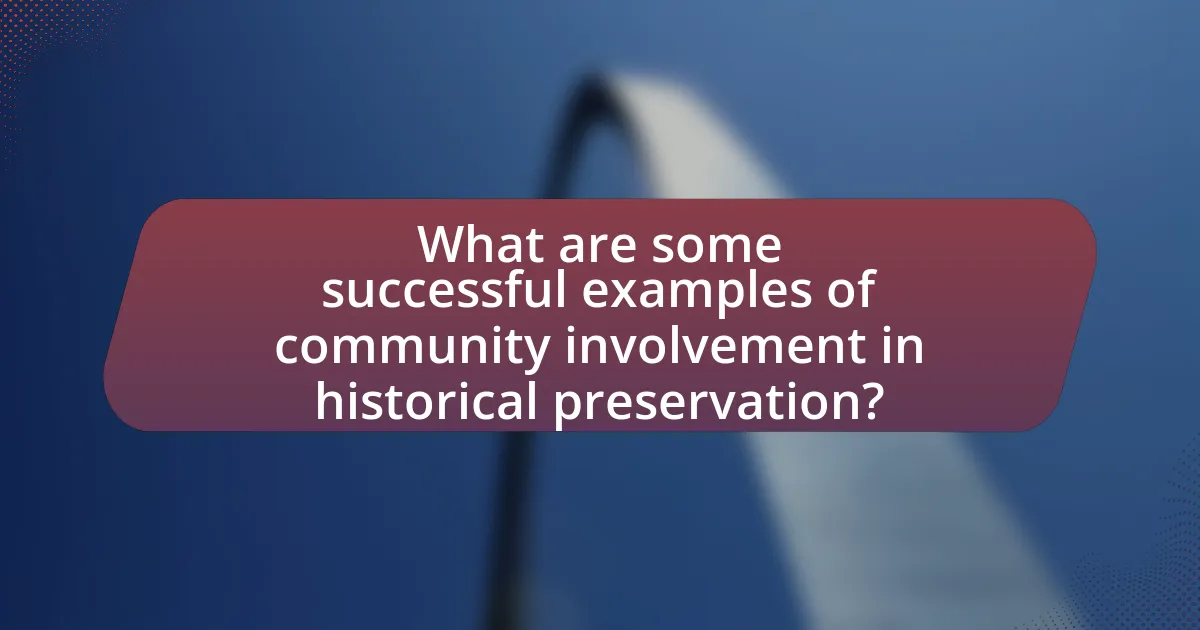
What are some successful examples of community involvement in historical preservation?
Successful examples of community involvement in historical preservation include the restoration of the historic district in Savannah, Georgia, and the efforts of the community in New Orleans to preserve the character of the French Quarter. In Savannah, local residents organized the Savannah Historic District Preservation Society, which played a crucial role in advocating for the preservation of the city’s unique architecture and heritage, resulting in the district being designated a National Historic Landmark in 1966. In New Orleans, community groups like the Vieux Carré Property Owners, Residents, and Associates have actively engaged in protecting the French Quarter from inappropriate development, leading to the establishment of strict zoning laws that safeguard its historical integrity. These examples demonstrate how community engagement can effectively influence preservation policies and practices.
What case studies highlight effective community-led initiatives?
Case studies that highlight effective community-led initiatives include the restoration of the historic district in New Orleans, Louisiana, and the preservation efforts in the town of Gentrification in New York City. In New Orleans, local residents organized to restore and preserve the character of their neighborhoods post-Hurricane Katrina, resulting in the successful revitalization of over 1,000 homes and businesses, supported by the National Trust for Historic Preservation. In New York City, community groups successfully campaigned to protect the historic architecture of Gentrification, leading to the designation of the area as a historic district in 2010, which has since increased property values and community engagement. These examples demonstrate the power of community involvement in preserving historical sites and fostering local identity.
How did specific communities achieve their preservation goals?
Specific communities achieved their preservation goals through organized grassroots efforts, collaboration with local governments, and securing funding for restoration projects. For instance, the Historic Districts Council in New York City mobilized residents to advocate for landmark designations, which protected neighborhoods from inappropriate development. Additionally, communities often formed non-profit organizations that focused on raising awareness and funds for preservation, such as the Preservation Alliance for Greater Philadelphia, which successfully campaigned for the restoration of historic sites through community engagement and educational programs. These initiatives demonstrate how collective action and strategic partnerships can lead to effective preservation outcomes.
What lessons can be learned from these successful initiatives?
Successful initiatives in community involvement for historical preservation demonstrate the importance of collaboration, local engagement, and adaptive strategies. These initiatives show that when communities actively participate in preservation efforts, they foster a sense of ownership and pride, which enhances the sustainability of the projects. For instance, the successful restoration of the historic district in Savannah, Georgia, involved local stakeholders who contributed to decision-making processes, resulting in increased public support and funding. Additionally, these initiatives highlight the effectiveness of educational programs that raise awareness about the value of historical sites, as seen in the community-led efforts in New Orleans post-Hurricane Katrina, where residents organized to protect their cultural heritage. Overall, the key lessons emphasize the necessity of inclusive participation, effective communication, and the integration of local knowledge in preservation efforts.
What role do technology and social media play in community involvement?
Technology and social media significantly enhance community involvement by facilitating communication, collaboration, and mobilization among community members. These platforms allow individuals to share information, organize events, and engage in discussions about local historical preservation initiatives. For instance, a study by Pew Research Center found that 69% of adults in the U.S. use social media, which serves as a vital tool for raising awareness and fostering participation in community projects. Additionally, technology enables the use of crowdfunding platforms, which can financially support preservation efforts, demonstrating a direct link between digital engagement and community action.
How can digital platforms facilitate community engagement in preservation?
Digital platforms can facilitate community engagement in preservation by providing accessible tools for collaboration, information sharing, and participation in preservation efforts. These platforms enable communities to connect with preservation initiatives through social media, dedicated websites, and mobile applications, allowing for real-time communication and feedback. For instance, platforms like Facebook and Instagram allow users to share stories, photos, and experiences related to local heritage, fostering a sense of community ownership and pride. Additionally, online crowdfunding platforms have successfully funded preservation projects, demonstrating community support and involvement. Research by the National Trust for Historic Preservation indicates that digital engagement can increase public awareness and participation in local preservation efforts, highlighting the effectiveness of these platforms in mobilizing community action.
What are the benefits of using social media for awareness and fundraising?
Using social media for awareness and fundraising significantly enhances outreach and engagement. Social media platforms allow organizations to reach a broader audience quickly, facilitating the dissemination of information about historical preservation initiatives. For instance, a study by the Pew Research Center found that 69% of adults in the U.S. use social media, providing a vast potential audience for campaigns. Additionally, social media enables real-time interaction, allowing organizations to engage with supporters, answer questions, and foster community involvement. This interactive nature can lead to increased donations; according to a report by Nonprofit Source, 55% of donors who engage with nonprofits on social media end up giving. Thus, social media serves as a powerful tool for raising awareness and funds for historical preservation efforts.
What practical steps can communities take to enhance involvement in preservation initiatives?
Communities can enhance involvement in preservation initiatives by organizing educational workshops and outreach programs that raise awareness about the importance of historical preservation. These initiatives can include collaboration with local schools, historical societies, and cultural organizations to provide resources and training on preservation techniques. For example, a study by the National Trust for Historic Preservation found that communities with active educational programs saw a 30% increase in volunteer participation in preservation activities. Additionally, establishing volunteer committees focused on specific preservation projects can foster a sense of ownership and responsibility among community members, further driving engagement and participation.

